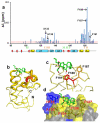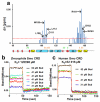Structural insights into the role of the Smoothened cysteine-rich domain in Hedgehog signalling
- PMID: 24351982
- PMCID: PMC3890372
- DOI: 10.1038/ncomms3965
Structural insights into the role of the Smoothened cysteine-rich domain in Hedgehog signalling
Abstract
Smoothened (Smo) is a member of the Frizzled (FzD) class of G-protein-coupled receptors (GPCRs), and functions as the key transducer in the Hedgehog (Hh) signalling pathway. Smo has an extracellular cysteine-rich domain (CRD), indispensable for its function and downstream Hh signalling. Despite its essential role, the functional contribution of the CRD to Smo signalling has not been clearly elucidated. However, given that the FzD CRD binds to the endogenous Wnt ligand, it has been proposed that the Smo CRD may bind its own endogenous ligand. Here we present the NMR solution structure of the Drosophila Smo CRD, and describe interactions between the glucocorticoid budesonide (Bud) and the Smo CRDs from both Drosophila and human. Our results highlight a function of the Smo CRD, demonstrating its role in binding to small-molecule modulators.
Figures







Similar articles
-
Structure and function of the Smoothened extracellular domain in vertebrate Hedgehog signaling.Elife. 2013 Oct 29;2:e01340. doi: 10.7554/eLife.01340. Elife. 2013. PMID: 24171105 Free PMC article.
-
Hedgehog pathway modulation by multiple lipid binding sites on the smoothened effector of signal response.Dev Cell. 2013 Aug 26;26(4):346-57. doi: 10.1016/j.devcel.2013.07.015. Epub 2013 Aug 15. Dev Cell. 2013. PMID: 23954590 Free PMC article.
-
The extracellular loops of Smoothened play a regulatory role in control of Hedgehog pathway activation.Development. 2012 Feb;139(3):612-21. doi: 10.1242/dev.075614. Development. 2012. PMID: 22223683 Free PMC article.
-
Evaluating Smoothened as a G-protein-coupled receptor for Hedgehog signalling.Trends Cell Biol. 2010 May;20(5):287-98. doi: 10.1016/j.tcb.2010.02.002. Epub 2010 Mar 5. Trends Cell Biol. 2010. PMID: 20207148 Review.
-
Mechanisms of Smoothened Regulation in Hedgehog Signaling.Cells. 2021 Aug 20;10(8):2138. doi: 10.3390/cells10082138. Cells. 2021. PMID: 34440907 Free PMC article. Review.
Cited by
-
Hedgehog Signaling in Cancer: A Prospective Therapeutic Target for Eradicating Cancer Stem Cells.Cells. 2018 Nov 10;7(11):208. doi: 10.3390/cells7110208. Cells. 2018. PMID: 30423843 Free PMC article. Review.
-
Targeting the Oncoprotein Smoothened by Small Molecules: Focus on Novel Acylguanidine Derivatives as Potent Smoothened Inhibitors.Cells. 2018 Dec 14;7(12):272. doi: 10.3390/cells7120272. Cells. 2018. PMID: 30558232 Free PMC article. Review.
-
Structural basis for Smoothened receptor modulation and chemoresistance to anticancer drugs.Nat Commun. 2014 Jul 10;5:4355. doi: 10.1038/ncomms5355. Nat Commun. 2014. PMID: 25008467 Free PMC article.
-
Remyelinating Drugs at a Crossroad: How to Improve Clinical Efficacy and Drug Screenings.Cells. 2024 Aug 8;13(16):1326. doi: 10.3390/cells13161326. Cells. 2024. PMID: 39195216 Free PMC article. Review.
-
Regulation of the oncoprotein Smoothened by small molecules.Nat Chem Biol. 2015 Apr;11(4):246-55. doi: 10.1038/nchembio.1776. Nat Chem Biol. 2015. PMID: 25785427 Review.
References
-
- Nüsslein-Volhard C, Wieschaus E. Mutations affecting segment number and polarity in Drosophila. Nature. 1980;287:795–801. - PubMed
-
- van den Heuvel M, Ingham PW. smoothened encodes a receptor-like serpentine protein required for hedgehog signalling. Nature. 1996;382:547–551. - PubMed
-
- Alcedo J, Ayzenzon M, VonOhlen T, Noll M, Hooper JE. The Drosophila smoothened gene encodes a seven-pass membrane protein, a putative receptor for the hedgehog signal. Cell. 1996;86:221–232. - PubMed
-
- Ingham PW, McMahon AP. Hedgehog signaling in animal development: paradigms and principles. Genes Dev. 2001;15:3059–3087. - PubMed
Publication types
MeSH terms
Substances
Associated data
- Actions
Grants and funding
LinkOut - more resources
Full Text Sources
Other Literature Sources
Molecular Biology Databases
Miscellaneous

